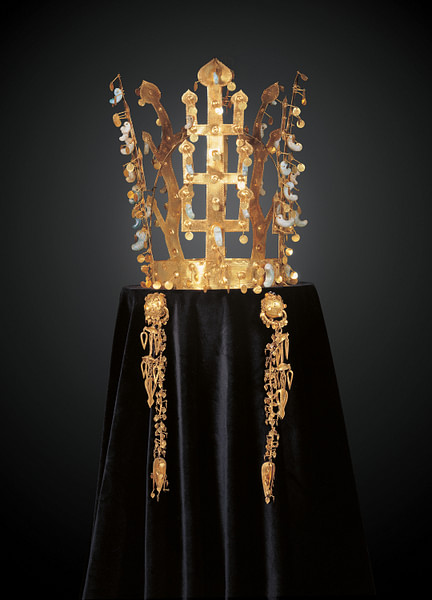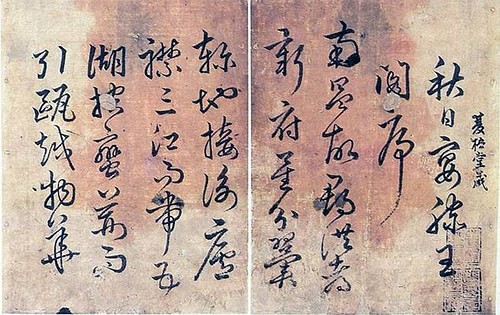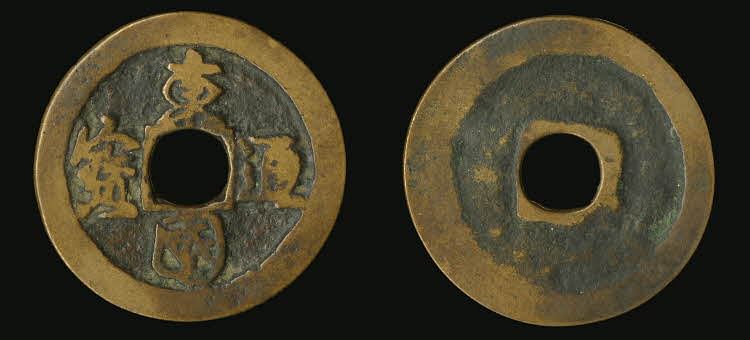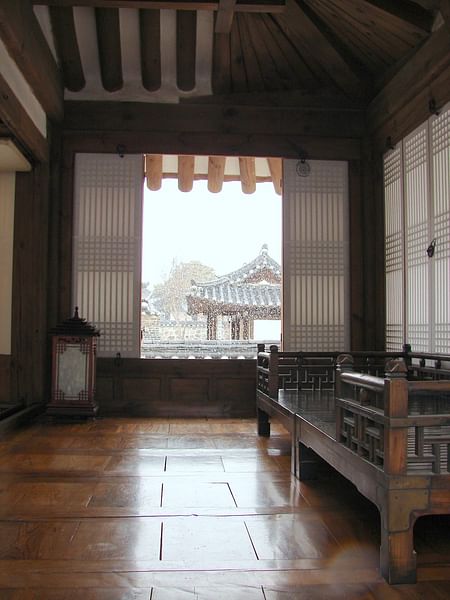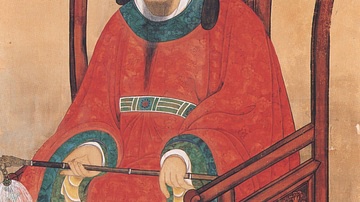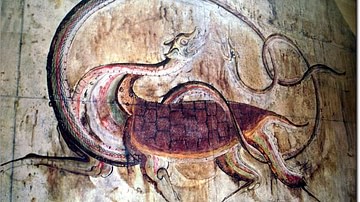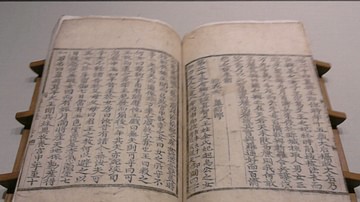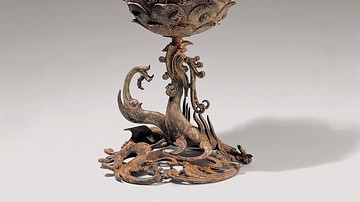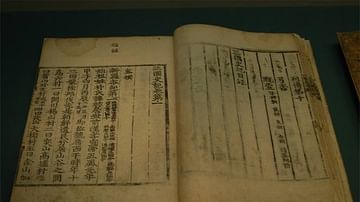
Korea, located on a large peninsula on the eastern coast of the Asian mainland, has been inhabited since Neolithic times. The first recognisable political state was Gojoseon in the second half of the first millennium BCE. From the 1st century BCE to the 7th century CE in the Three kingdoms period, the peninsula was dominated by the kingdoms of Baekje, Goguryeo and Silla, along with the Gaya confederacy.
Silla, with significant Chinese aid, would eventually conquer all of the other Korean states and form the Unified Silla Kingdom which ruled until 935 CE. From the 10th century CE, the peninsula was ruled by the Goryeo kingdom until Korea's independence was brought to an end by the Mongol invasions of the 13th century CE.
Close cultural and political ties were maintained with China, albeit with significant periods of conflict between the two areas. Japan was another trading partner and was also involved in Korean cultural exchange. Ancient Korea has provided many unique contributions to world culture including the invention of movable metal type printing, superb celadon ceramics, the exquisite gold crowns of Silla, the oldest astronomical observatory in Asia, fine gilt-bronze Buddhist figurines, stone pagodas, hanji, the most prized paper in the world, and the ondol underfloor heating system.
Prehistoric Korea
The Korean peninsula was inhabited from 10,000 BCE (or even earlier) by people who subsisted on hunting, fishing, and gathering. The earliest known settlements date to c. 6,000 BCE. Megalithic structures from the 2nd millennium BCE still dot the landscape of Korea and number over 200,000. Dolmens were constructed of huge single stones and were likely used as tomb markers. Other types of burials take the form of stone-lined cist graves with precious goods such as amazonite jewellery being buried with the deceased.
Dwellings of this period are typically subterranean with a roof supported by poles and have a central hearth. Villages tend to be located on hillsides and sometimes enclosed within a wooden perimeter fence. Archaeological finds include jewellery made from stone, bone and shell; chipped stone hand-axes; stone pestle and mortars; stone ploughs, sickles, and hoes; and obsidian or slate arrowheads. Early pottery, especially in the form of flat-bottomed brown bowls with incised decoration, shows a cultural link with communities in the Liaoning province and Liaodong peninsula of China. Neolithic pottery and obsidian objects also indicate an early maritime trade with ancient Japan.
Agriculture was first practised from the second millennium BCE and aided by the introduction of rice cultivation from China by 700 BCE. The Korean Bronze Age covered the same period with the metal culture brought from Manchuria. The presence of fine bronze goods such as swords, bells, and mirrors in certain tombs along the Taedong River indicates a culture with a tribal elite. Other common bronze items include slender daggers, spearheads, belt buckles, and fan-shaped axes. The Korean Iron Age began in the 3rd century BCE as evidenced by tomb finds of that date in Gyeongju. It was in this period that the first state was formed, Gojoseon.
Gojoseon
Gojoseon, according to Korean mythology as recounted in the 13th-century CE Samguk yusa ('Memorabilia of the Three Kingdoms'), was founded in 2333 BCE by Dangun Wanggeom (aka Tangun) who was the offspring of the god Hwanung and a female bear transformed into a woman. Archaeological evidence suggests that the state was formed from the alliance of small fortified towns around the Daedong and Liao River basins perhaps from the 7th century BCE and more certainly from the 4th century BCE. Although mentioned in the c. 100 BCE text Records of the Grand Historian written by the Chinese historian Sima Qian, modern historians continue to debate whether it is possible to describe Gojoseon as a state proper, when exactly did it exist, where was its capital, and what were the exact territories under its control.
Gojoseon prospered due to agricultural improvements (with iron tools introduced from China) and plentiful natural resources like gold, silver, copper, tin, and zinc. At this time the famous ondol underfloor heating system was invented and the first Korean grey stoneware produced. However, Gojoseon was weakened by attacks from the neighbouring Yan state c. 300 BCE, and a long decline set in. Gojoseon finally collapsed in the 2nd century BCE, and its successor, Wiman Joseon, did not last very long either for in 108 BCE it was conquered by the Han Dynasty of China (206 BCE – 220 CE). The Han were interested in natural resources such as salt and iron and they divided northern Korea into four commanderies directly administered by their central government.
Gojoseon's territories would later become Goguryeo (Koguryo) while the southern part of Korea at this time, often referred to as the Proto-Three Kingdoms Period, was spilt into the Three Hans of Byeonhan, Mahan, and Jinhan (no connection to the Chinese Han), which became the three states of Baekje (Paekche), Gaya (Kaya), and Silla in the subsequent Three Kingdoms Period. These kingdoms benefitted from the sophisticated culture brought by refugees from the collapsed Gojoseon and defeated Wiman Joseon states.
Three Kingdoms Period
The four states of the Three Kingdoms Period (57 BCE – 668 CE) were in constant rivalry and so they formed ever-changing alliances, one with another and with the two dominant regional powers of China and Japan. According to a tradition based on the 12th-century CE Samguk sagi ('Historical Records of the Three States') this happened from the 1st century BCE, but modern historians prefer the 2nd or 3rd century CE (or even later) as a more accurate date when the states could be described as having more centralised governments.
Goguryeo, with its capital at Pyongyang, particularly prospered in the 5th century CE during the reign of Gwanggaeto the Great (391-413), who lived up to his other title of 'broad expander of domain,' and permitted Goguryeo to dominate northern Korea, most of Manchuria, and a portion of Inner Mongolia. Silla, meanwhile, with its capital at Geumseong (Gyeongju) flourished under the reign of king Beopheung (r. 514-540 CE), achieving a much greater degree of centralisation and prospering on the eastern coast due to agricultural innovations such as oxen-drawn ploughs and irrigation systems. Gaya, squeezed between its more powerful neighbours in the south of the peninsula, never fully developed into a centralised kingdom. Silla captured the Gaya ruling city-state Geumwan Gaya (Bon-Gaya) in 532 CE, and the state collapsed completely a few decades later. Baekje had done well in the late 4th century BCE under king Geunchogo and had formed its capital at Hanseong (modern Gwangju). An alliance with Silla between 433 and 553 CE brought some stability, but in 554 CE at a battle at Gwansanseong Fortress (modern Okcheon) Baekje tried to reclaim territory it had lost to a Silla invasion and their 30,000-strong army was defeated and the Baekje king Seong killed.
The system of government of the three kingdoms was much as it would remain for the rest of the history of ancient Korea. A monarch ruled with the aid of senior administrative officials drawn from a landed aristocracy. Government appointed officials administered the provinces with the aid of local tribal leaders. The majority of the population were landed peasantry, and the state extracted a tax from them which was usually payable in kind. The state could also oblige citizens to fight in the army or work on government projects such as building fortifications. At the very bottom of the social ladder were slaves (typically prisoners of war or those in serious debt) and criminals, who were forced to work on the estates of the aristocracy. Society was rigidly divided into social ranks, best epitomised by the Silla sacred bone rank system which was based on birth and dictated one's work possibilities, tax obligations, and even the clothes one could wear or the utensils one could use.
The in-fighting between the Korean states was finally settled by outside intervention from China. Goguryeo had successfully rebuffed three invasions from Sui China in the 7th century CE, and then the Tang Dynasty (618-907 CE) attempted an invasion in 644 CE, but the great general Yang Manchun once again brought victory to the Koreans. Goguryeo had joined forces with Baekje and successfully invaded Silla territory two years before, but the Tangs were not done with their plans for Korea and they decided on Silla as their temporary ally to defeat the other two remaining Korean states. In 660 CE, a Silla army of 50,000 led by the general Kim Yu-sin and a naval force of 130,000 men sent by the Tang emperor Gaozong proved more than enough to crush Baekje and its king, Uija, was taken to China. Then in 667 CE Pyongyang fell, and the next year the Goguryeo king Bojang was likewise taken prisoner to China along with 200,000 of his subjects. Silla had no intention, though, of becoming a Chinese vassal state and defeated the remaining Tang army in battles at Maesosong (675 CE) and Kibolpo (676 CE). Silla then took control of all of Korea in 668 CE, forming a new state, the Unified Silla Kingdom.
Unified Silla Kingdom
The Unified Silla Kingdom (668- 935 CE) was the first dynasty to rule over the whole of the Korean peninsula. There was a state in the north at this time, Balhae (Parhae), but most of its territory was in Manchuria and so the majority of historians do not consider it a Korean state proper.
The whole state was now divided into nine provinces (three in each of the old three kingdoms) and five secondary capitals. Geumseong continued as the overall capital, then known as Seorabeol, which benefitted from an extensive rebuilding programme, pleasure palaces and temples, and would eventually boast a population of around 900,000. A whole series of administrative regions, prefectures and counties were created right down to village level. To consolidate the kingdom, troublesome peoples and the ruling elites of the former kingdoms were forcibly relocated and village headmen were compelled to send their eldest sons to work in the capital administration or military. The kingdom prospered due to a thriving agricultural industry, which was made more productive via extensive irrigation projects, and trade throughout the East China Sea. The prolonged absence of war also meant that the arts and sciences flourished as never before.
The state began a slow decline from the 8th century CE, largely due to the rigidity of its class structure, still based on the bone rank system, the strict social classification of entitlements and obligations. Not only did the lack of opportunity to rise above the class of one's birth create a stagnation of ideas and innovations but the aristocracy began, too, to resent the power of the king. At the other end of the social ladder, the peasantry grew more and more resentful of the incessant taxes levied upon them. On top of that, local landed aristocrats became ever more difficult to control from the capital. The state was falling apart from within.
Two individuals would cause particular trouble for the Silla kings. One Gyeon Hwon, a peasant leader, took advantage of the political unrest in 892 CE and formed a revival of the old Baekje kingdom in the south-west. Meanwhile, an aristocratic-Buddhist monk leader, Gung Ye, declared a new Goguryeo state in the north in 901 CE, known as Later Goguryeo. There then followed another messy power struggle for control of the peninsula just as there had been in the Three Kingdoms Period, indeed this period is often referred to as the Later Three kingdoms Period. Kyon Hwon attacked Geumseong in 927 CE while Gung Ye's unpopular and fanatical tyranny led to his death at the hands of his people. He was succeeded by his first minister, the able Wang Geon, in 918 CE, who attacked Later Baekje, now beset by leadership in-fighting, and then Silla. The last Silla king, Gyeongsun, surrendered in 935 CE and left Wang Geon to unify the country once again but under a new name, the Goryeo Dynasty.
Goryeo
Goryeo (Koryo) would rule Korea from 918 CE to 1392 CE, and it is the name of this kingdom which is the origin of the English name for the peninsula, Korea. Wang Geon selected the northern city of Songdo (Modern Gaeseong) as his new capital and declared himself king. For his contribution to creating the new state he was given the posthumous title King Taejo or 'Great Founder.' The new state was not without its external threats, and the Khitan (Qidan) tribes to the north attacked Goryeo twice. In 1033 CE they were finally defeated, and a defensive wall was built stretching right across the northern Korea border.
From then on the kingdom flourished and the capital Songdo boasted over 1,000 shops. For the first time Korea minted its own coinage (996 CE), and the unbyong (aka hwalgu) silver vases were made from 1101 CE which took the shape of the Goryeo empire and were marked as legitimate currency by having the official state seal engraved on them. Movable metal type printing was invented and the older method of woodblock printing refined. The period then saw a boom in Buddhist texts and an interest in documenting the history of the country with the famous Samguk sagi ('History of the Three Kingdoms') written in 1145 CE by Kim Pu-sik.
Prosperity had its downside and resulted in a steadily increasing decadence among the ruling elite, corruption, and social unrest. Open rebellions broke out in 1126 and 1135 CE which were ultimately quashed, but matters came to a head in the reign of king Uijong who was much criticised for building lavish palaces and water parks. The military, with not much else to do and no status in higher society, staged a coup in 1170 CE. Uijong was replaced by his brother Myeongjong but he only remained as a puppet sovereign. Decades of turbulent in-fighting between all levels of Goryeo society ensued with more coups, assassinations, and slave rebellions. Worse was to come, though. Ghengis Khan, who had unified the Mongol tribes, had swept across China, and his son Ogedei Khan turned his attention to Korea in 1231 CE. Goryeo was forced to move its capital to Ganghwa Island the following year. While the ruling elite was safely ensconced on their island, the rest of the Goryeo population had to face six Mongol invasions over the next three decades. By 1258 CE, the people had had enough and the military ruler was assassinated, the king reinstalled with full powers, and peace made with the Mongols. Korea would not be independent again until the general Yi Seong-gye formed the new state of Joseon in 1392 CE.
Relations with China & Japan
Relations between Korea and China go back to mythology when the sage Gija (Jizi to the Chinese) and 5,000 followers left China and settled in Dangun's kingdom. When the latter decided to retreat to meditation on a mountaintop, Gija was made king of Gojoseon in 1122 BCE. This myth may represent the arrival of Iron Age culture to Korea.
Trade between the two areas went on throughout this period. Iron, gold, silver, copper, ginseng, hemp goods, pine nuts, furniture, paper, and horses were exported to China, and silk, tea, spices, medicine, ceramics, books, and writing materials came in the other direction. Chinese culture was likely brought to Korea by refugees fleeing the 4th-century BCE conflicts of the Warring States Period. Archaeological evidence of this early cultural influence is perhaps best seen in the use of pit burial tombs in the Daedong River area and the frequent presence of horse trappings therein. Later cultural ties are more clearly defined with Korea adopting the Chinese writing system, the kingly title of wang, coinage, literature, and elements of art. Students and scholars frequently went to study in China.
Similarly, diplomatic and cultural relations with Japan were ongoing from the Bronze age onwards. The Wa (Wae) of Japan had particularly strong ties with the Gaya confederation. The latter was the more advanced culture and exported large quantities of iron, but just how much one state influenced or even controlled the other is still debated by scholars. Baekje culture was exported to Japan, especially via teachers, scholars, and artists, who also spread there Chinese culture such as the classic texts of Confucius. Relations were maintained with southern Japan by the Unified Silla kingdom, especially in the Nara and Heian periods. Goryeo, too, continued trade relations and imported Japanese goods, especially swords and paper folding fans.
Korean Religion
The Korean states, traditionally practitioners of shamanism, adopted first Confucianism, then Taoism and Buddhism from China, with Korea making the latter the official state religion from the 4th century CE. Confucian principles were followed in the state administration and were an essential part of entrance exams to positions within that system. Buddhism was the strongest faith, though, and temples and monasteries sprang up everywhere. The Buddhist temple-monasteries, with their landed estates, royal patronage, and exemption from tax, became wealthy and the whole religious apparatus rivalled that of the state itself. Many such monasteries even had their own armed forces recruited from warrior-monks and the general populace. Buddhism was practised not only by the elite families, which often sent a son to study at a monastery and become a monk, but also by the lower classes.

Korean Art
High-fired grey stoneware was produced in great quantities from the Three Kingdoms Period. Ceramics were decorated with incisions, applying additional clay pieces, and cutting away the clay to create a latticework effect. The most famous Korean ceramics from any period, though, are the pale green celadons produced in the Goryeo kingdom. Also known as greenware, these have a smooth glaze and typically have fine inlaid designs (sanggam), especially Buddhist motifs such as the lotus flower, cranes, and clouds. Celadons were first introduced into Korea from China during the 9th century CE, but Korean potters became so skilled at their manufacture that their wares were exported back to China and, even today, Korean celadons are amongst the most prized ceramics in the world.
Tomb-painting is best seen in the tombs of Goguryeo. Over 80 of them have chambers decorated with brightly painted scenes of everyday life, portraits of the occupants, and mythical creatures. The paintings were made by applying the paint either directly onto the stone wall or onto a lime plaster base.

Buddhist art was popular throughout the peninsula, and gilt-bronze was used to produce expressive statuettes of Buddha, Maitreya (the coming Buddha), and bodhisattvas. Monumental figures were carved from boulders and into rock faces too. Gilt bronze was also used to manufacture ornate incense burners, relic boxes, and crowns. The most famous Korean crowns are those of the Silla kingdom made in sheet-gold. These have trees and stag-like branches which represent a link with shamanism. Jewellery of all kinds was made using goldwork techniques such as wiring, punching, cutting, and granulation. Jade, often carved into crescent moon shapes, was a popular form of embellishment for these glittering adornments. Another skill of Korean metalworkers from the Unified Silla kingdom onwards was the casting of large bronze bells (pomjong) which were used in Buddhist temples to announce services.
Korean Architecture
The best surviving remains of Korean architecture from the period prior to recorded history are megalithic structures, fortification walls, and stone-lined tombs. Outstanding examples of ancient Korean dolmens are the table-type structures on Ganghwa Island which date to c. 1000 BCE in the Korean Bronze Age. Single standing stones (menhirs), unrelated to a burial context and perhaps used as marker stones, are also found across Korea.
Unfortunately, there are few surviving public buildings from ancient Korea prior to the 16th century CE. The architecture of ancient Korea is, then, best seen in tomb paintings and those structures which do still stand such as the stone pagoda of the Baekje Mireuksa temple at Iksan which has six of its original 7-9 storeys. Stone pagodas are Korea's unique contribution to Buddhist architecture with two other fine examples being the Dabotap and Seokgatap pagodas at the 8th century CE Bulguksa temple near Gyeongju.
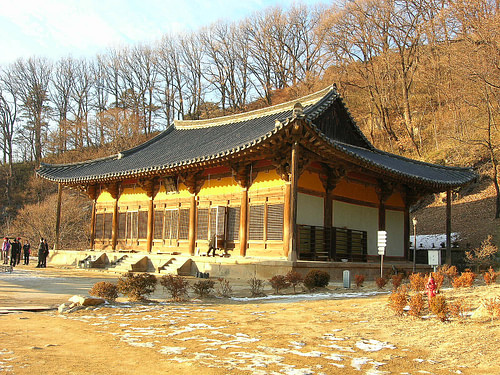
Large mound tombs are typical of the Three Kingdoms Period. These are earth-covered mounds with interior stone-lined or brick interior chambers for the deceased, usually with a horizontal entrance passage (except Silla tombs which have no access point). One of the largest such tombs is at the once Goguryeo capital Gungnae (modern Tonggou) and thought to be that of King Gwanggaeto the Great (r. 391–412 CE). It is 75 metres long and using blocks measuring 3 x 5 metres.
One of the outstanding stone structures from the Unified Silla Period is the Buddhist Seokguram Grotto temple east of Gyeongju. Constructed between 751 and 774 CE, it contains a circular domed inner chamber within which is a massive seated Buddha. Another interesting Silla structure is the mid-7th century CE Cheomseongdae observatory. 9 metres tall, it acted like a sundial but also has a south-facing window which captures the sun's rays on the interior floor on each equinox. It is the oldest surviving observatory in East Asia.
A good idea of the Korean architectural style for larger houses and palaces is seen in the 13th-century CE Goryeo Hall of Eternal Life (Muryangsujeon) at the Pusok temple in Yongju. It is one of the oldest wooden structures surviving in the whole of Korea. Roofs of Korean buildings, as seen in the Hall of Eternal Life, are typically high-pitched to allow easy drainage of rainwater and strong enough to resist the weight of snow in winter. They are also high to permit air-flow in the warmer months. Ancient roofs were made of wooden beams and then tiled (giwa) over a layer of earth to provide extra insulation. The roofs are concave for aesthetic purposes, and the eaves also gently curve upwards (cheoma). This curvature permits extra sunlight in winter to enter the building and at the same time provide a little extra shade in summer.
Interior walls of traditional Korean buildings (hanok) were made of wood and paper, often functioning as sliding doors (changhoji). The floors of rooms could be either in wood and slightly elevated (the maru system) to keep the room cool in hot months or used the ondol system of underfloor heating necessary for winter months. This latter type, made of stone with a waxed paper covering, has a system of flues through which hot air flows from the main hearth of the house. External doors and windows were made using interlocking grids of wood (changsal), often carved into highly decorative latticework (kkotsal). The home was divided into purpose-specific areas and typically enclosed a courtyard or garden area.
Finally, the immediate topography of buildings was an important consideration so that architects endeavoured to harmoniously blend their designs into the natural environment (pungsu) and take advantage of scenic views (andae). The best possible place was a site which was backed by mountains to block the wind and opened onto a wide plain with a river running through it to provide the home with positive energy or gi.
This content was made possible with generous support from the British Korean Society.


